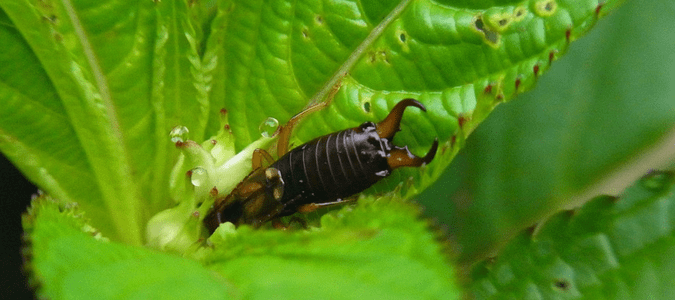
Earwigs are small, flat insects that measure about half an inch long and an eighth inch in width when full-grown. Dark brown and shiny, they have banded abdomens that end in a long pair of scary-looking pinchers. If you’ve ever tried to pick up an earwig, you may have gotten pinched—but you also probably noticed those pinchers weren’t very powerful. An earwig’s pinch might make you yelp in surprise. Still, it probably won’t break the skin, and it almost always happens defensively—meaning the earwig is frightened and trying to fight off a more significant, scarier enemy (you!). So why are earwigs called earwigs, and are the rumors true—do earwigs crawl in your ear? Let’s find out more about this often-misunderstood insect.
If you’ve ever tried to pick up an earwig, you may have gotten pinched—but you also probably noticed those pinchers weren’t very powerful. An earwig’s pinch might make you yelp in surprise. Still, it probably won’t break the skin, and it almost always happens defensively—meaning the earwig is frightened and trying to fight off a more significant, scarier enemy (you!). So why are earwigs called earwigs, and are the rumors true—do earwigs crawl in your ear? Let’s find out more about this often-misunderstood insect.
Why Are Earwigs Called Earwigs?
The source of the earwig’s unfortunate name is the commonly held idea that while humans sleep, earwigs crawl into their ears to lay eggs in people’s brains. Yuck!
Fortunately, this story is nothing more than a myth. While it’s certainly possible, even likely, that at some point in human history, an earwig has crawled into someone’s ear, it was probably an accidental and isolated incident.
The good news is, this happens only rarely, and as horrifying an experience as it might be, it probably wasn’t on purpose in the earwig’s case. Earwigs do not make it a point to seek out sleeping humans’ ears for expeditions.
Where Do Earwigs Live and What Do They Eat?
What do earwigs eat if they don’t lay eggs in human brains or feed on our gray matter? Their main dietary staple is damp, rotting leaves and wood, which is why they often make their homes in dead tree stumps and beneath piles of mulch or leaves in gardens. They might also occasionally consume living plants, vegetables, and small insects like aphids or mites. But generally speaking, earwigs tend to stick to decaying plant matter as their primary food source.
Do Earwigs Infest Homes or Cause Other Damage?
So now we know earwigs don’t consider humans a delicacy and don’t seek out our ear cavities for making nests or laying eggs. Do they cause any other damage or trouble that might affect humans? The short answer is no. While an earwig might enter your home by accident, it’s not likely to seek indoor shelter unless it’s scorched outside. In that case, earwigs might explore inside your home, especially if you live in greenhouse conditions, keeping lots of indoor plants with moist, dense soil that earwigs can access easily. But unlike termites or other destructive and invasive pests, earwigs are highly unlikely to infest your home and won’t cause structural damage if they do.
While an earwig might enter your home by accident, it’s not likely to seek indoor shelter unless it’s scorched outside. In that case, earwigs might explore inside your home, especially if you live in greenhouse conditions, keeping lots of indoor plants with moist, dense soil that earwigs can access easily. But unlike termites or other destructive and invasive pests, earwigs are highly unlikely to infest your home and won’t cause structural damage if they do.
What Should You Do if You Find Earwigs Indoors?
If you find just one or two little insects, they likely got in by accident and want to leave just as much as you want them out. In that case, sweep them up and transport them outdoors, where they can continue living in their natural habitat.
You can also take preventative measures to control earwig populations on your property, which will help prevent them from entering your home in the first place. These measures include the following:
- Rake up leaves when they fall so they don’t create damp and attractive earwig nesting grounds.
- Remove rotting tree stumps and other decaying plant matter from your property and around your home, again as a way to reduce potentially attractive nesting spots for these and other insects.
- Ensure rainwater is directed away from the house with proper grading, working gutters, French drains, etc.
- Try not to spread mulch right up to the house when mulching trees or garden beds.
Remember, earwigs are attracted to moist plant matter. The closer they can live to your home, the more capable they’ll be of finding their way indoors. Keeping wet plant matter away from your home is critical in maintaining earwigs out of your house and your life—and perhaps most importantly, to minimize the improbable possibility they will make it into your ears.
Trust ABC As Your Go-To For Pest Removal
If you regularly deal with wandering earwigs inside your home or find so many earwigs that it seems they must have laid eggs or taken up residence inside, you may need to take other measures. If you find yourself in this situation, or if you need help with any other common household pest, call our professionals at ABC Home & Commercial to come to assess your situation and come up with a customized plan to resolve the issue.